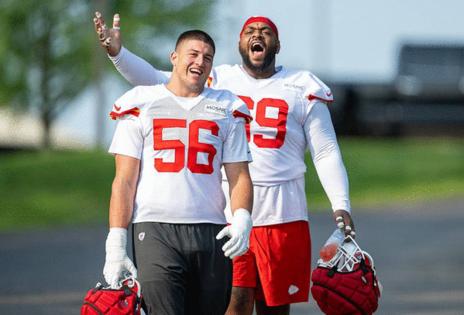Sam McDowell: Two reasons why the Chiefs signed George Karlaftis before they really needed to
Published in Football
ST. JOSEPH, Mo. — Five days before traveling an hour north for training camp, the Chiefs provided Trey Smith a four-year contract that reset the NFL’s right guard market and makes him the highest-paid player at the position.
Five hours before training camp, the Chiefs provided George Karlaftis a four-year contract extension that hovers, oh, about 10th in annual average value among the NFL’s best-paid edge rushers.
You could argue Smith and Karlaftis are different caliber players at their respective positions — Smith has made one Pro Bowl and Karlaftis none. So, sure, you could make that argument. Subjectively.
But there’s an objective difference.
Timing.
Smith was set to hit free agency this offseason, before being placed on the one-year franchise tag. His payday was coming, whether from Kansas City or elsewhere.
Karlaftis has one year left on a rookie deal and then another option season that the Chiefs already exercised earlier this summer. He was under team control for two more years even absent the extension. Which means, by the time this new extension (four years, up to $93 million) actually kicks in, he will have slid, what, another 10 spots down the edge rusher ladder? More?
The Chiefs made the decision on Karlaftis long before they really needed to make the decision on Karlaftis. It comes with increased risk — this is the NFL, and things happen, after all — but it will save the organization some long-term money.
There are no A-plus deals in free agency or extensions, but rather reasonable deals — and the Chiefs found one, and they will profit from finding it early.
This isn’t to point out a magical lesson for the future.
It’s more about the takeaways, of which there are a couple.
Why the Chiefs signed Karlaftis: Reason No. 1
The first: The Chiefs have seen enough with Karlaftis through three seasons to consider him a core piece. On Sunday, at the outset of camp, coach Andy Reid called him relentless, reliable, trustworthy.
But mostly, he’s just remarkably consistent.
Well, I thought.
Karlaftis has always been a high-floor player, because he’s a high-effort player. But I previously would have told you we probably have seen his ceiling, too.
And then the back half of 2024 arrived.
A year ago, only once in the first 12 games did Karlaftis record a quarterback pressure rate of at least 10%. He rarely altogether disappeared in games — that high floor — but rarely starred. That’s who he was.
But then he topped that number (10% pressure rate) in each of his final seven games. Seriously, from 1 for 12 ... to 7 for 7.
Karlaftis had pressure rates of 13.3%, 20.6%, 13.5% and 11.8% in his last four regular-season games, and then 23.5%, 12.1% and 13.0% in the playoffs. He generated more pressures (13) than any edge rusher in football from Weeks 14-17, per PFF data.
And the Chiefs might not have had a better player on the field against the Houston Texans in the AFC Divisional Round game at GEHA Field at Arrowhead Stadium.
If that’s who Karlaftis is — and it’s notable this isn’t just one game, but rather seven consecutive — the Chiefs got a bargain.
Maybe there is another ceiling there.
It’s why I’m a little surprised that he was interested in signing now, given proof of that kind of sustained production over a full season would undoubtedly increase his value.
Why the Chiefs signed Karlaftis: Reason No. 2
The second takeaway? It relates to the offseason as a whole.
The Chiefs were relatively quiet in free agency. Their most expensive acquisition, Jaylon Moore, might not even start in Week 1. In fact, I’d predict he won’t.
But don’t get confused: They spent a lot of money this offseason.
On their own guys.
They made Smith the highest-paid right guard; they gave Karlaftis the extension; and they signed Nick Bolton to the fifth priciest off-ball linebacker contract in the game.
Put together, the strategy is quite clear: The Chiefs are feeling compelled to retain good players, regardless of position. (The Karlaftis contract is more comfortable given he plays a premium position, but I digress.)
Drafting 31st and 32nd makes it more difficult — certainly not to be confused with impossible, but harder — to find really good core players. Because of that hurdle to date — and the optimistic but realistic possibility that hurdle sticks around for awhile — it becomes a bigger risk to let players walk. They’re harder to replace.
That’s where the Chiefs are — less willing to take the chance on replacing them.
They were confronted with that scenario at the onset of this offseason, the thought of playing without Smith or without Bolton. They eventually relented, and they’ll pay a premium for non-premium positions.
They pounced with Karlaftis. A manageable deal, made more manageable in a couple of years, for a position that’s hard to find.
It’s a key difference in finances.
Even if the result is the same: They’re keeping their own.
____
©2025 The Kansas City Star. Visit kansascity.com. Distributed by Tribune Content Agency, LLC.







Comments